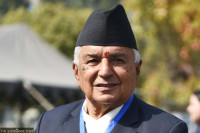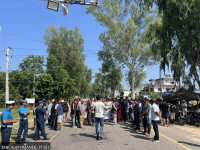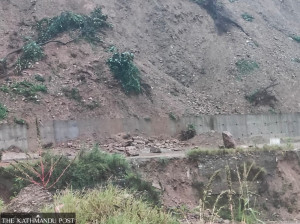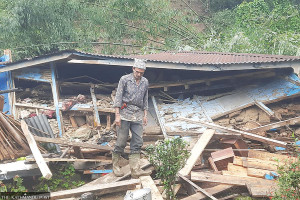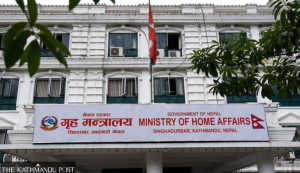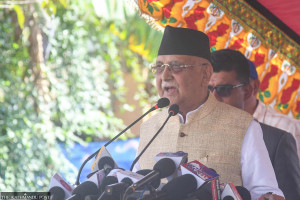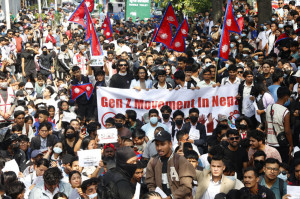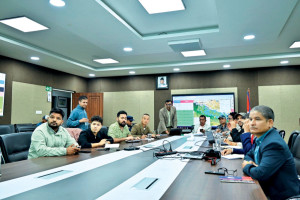National
Scores dead as rains batter Nepal’s east and south
The hill district of Ilam was the worst hit with at least 37 killed and seven missing.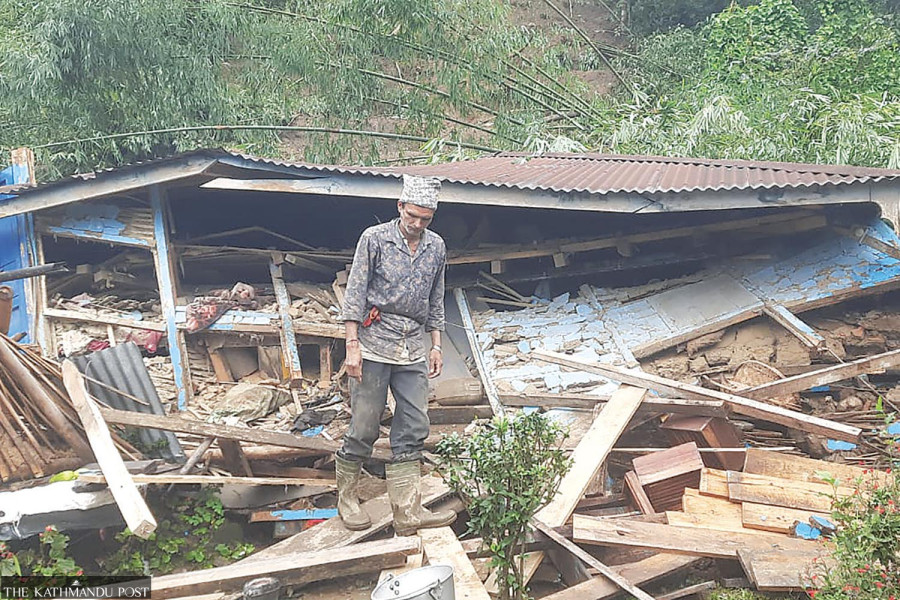
Laxmi Gautam & Parbat Portel
Late monsoon rains have wreaked havoc across the country, mainly in Bagmati, Madhesh and Koshi provinces. The nationwide death toll caused by water-induced disasters on Saturday and Sunday has reached at least 47.
Authorities said nine people remain missing, while more than 20 others have been injured in rain-induced disasters in the country’s eastern and southern regions. Search and rescue efforts continue, with security personnel mobilised in the affected areas.
Ilam, a hill district of Koshi province, is the worst hit by the monsoon mayhem. The death toll from the landslides triggered by continuous rainfall since Saturday night in Ilam has reached 37, according to the chief district officer, Sunita Nepal.
Three deaths have been reported in Rautahat, two in Panchthar, two in Udayapur, two in Khotang, and one in Kavrepalanchok.
By Sunday evening, landslides in various parts of Ilam had claimed 37 lives. According to the District Administration Office, five people died in Suryodaya Municipality, six in Ilam Municipality, six in Sandakpur Rural Municipality, three in Mangsebung, eight in Maijogmai, eight in Deumai Municipality, and one in Phakphokthum Rural Municipality. Among the deceased are 17 men and 20 women, including eight children, the office said in its official report.
Seventy-year-old Sharada Devi Sedhain and her 45-year-old daughter Indra lived in their home at Tari in ward 3 of Sandakpur Rural Municipality. The house stood on firm ground, and no one in the neighbourhood expected the area could be hit by a landslide. But on Saturday night, relentless rainfall triggered a landslide that swept away the irrigation canal above their home, completely burying the house and killing both mother and daughter.
The landslide began when the water from the canal eroded the soil, turning into a torrent of mud and debris that destroyed everything in its path.
“No one had thought a landslide would strike this area—nowadays, disasters like this don’t spare even flat or sloping land,” said neighbour CP Sharma Gadtaula. “There was a canal that flowed year-round above the Sedhains’ house. A small mound collapsed and blocked the water. When it overflowed, the water dug into the bamboo grove uphill and turned into a landslide that buried the house. Both mother and daughter died where they were sleeping.”
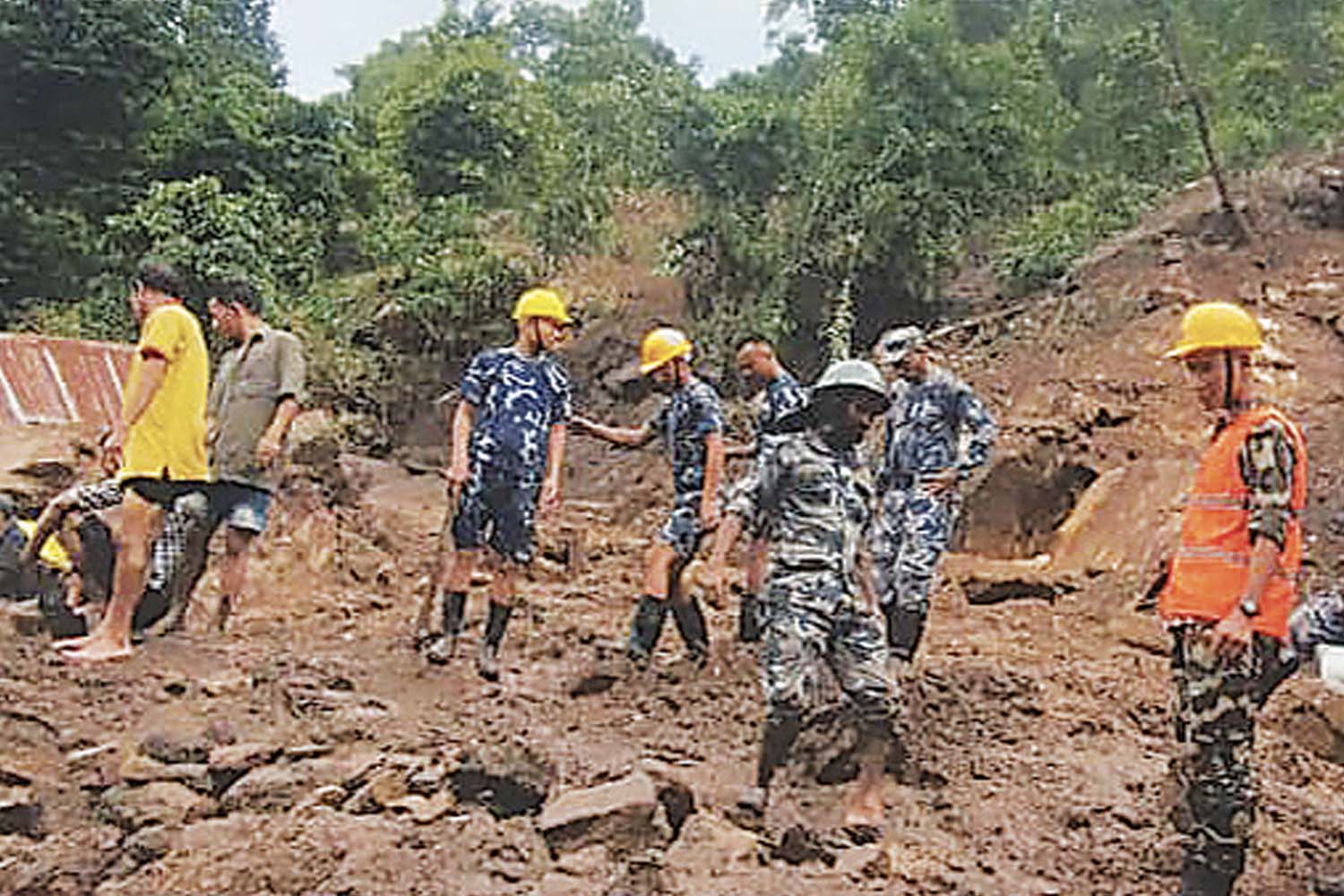
Throughout the night, heavy rain was accompanied by thunder and lightning, and no one in the neighbourhood realised a landslide had struck until the morning. “At daybreak, I looked out into the yard and saw the house buried,” recalled another neighbour, Khoma Ddevi Gadtaula. “We cried for help, and when neighbours and police came to clear the debris, both mother and daughter were dead.”
At Ghos in ward 6 of Ilam Municipality, another tragedy unfolded when a landslide swept through the home of Biraj Pakhrin Tamang, killing six people. Three were members of the Tamang family, and the other three were guests staying overnight.
“Landslides had never been predicted in that area either,” said veteran local journalist Satendra Jagegu. “People had lived there for generations. No one imagined a landslide could reach that far. But when the debris of mud and stones came crashing down from above, six lives were lost in an instant.”
One person has gone missing after being buried by a landslide in Ilam Municipality, while 20 others have been injured in different parts of the district. Among the injured, three were rescued by a Nepali Army helicopter, officials said.
In the neighbouring Panchthar, two people were killed after landslides struck separate locations—one in Tumbewa Rural Municipality and another in Phalgunanda Rural Municipality—according to Rupesh Tamang, information officer at the District Police Office, Panchthar.
The Department of Hydrology and Meteorology had forecast heavy rainfall, floods, landslides, and other disasters between September 2 and 5. In response, the disaster management committees of Ilam and Panchthar had identified high-risk areas prone to floods and landslides.
The Ilam District Disaster Management Committee had listed more than 20 locations as vulnerable to road blockages, flooding, landslides, inundation, and erosion. However, Ilam’s Chief District Officer Sunita Nepal said that except for Rajduwali, none of the affected sites had been categorised as high-risk.
“Rajduwali had been identified as dangerous for both floods and landslides, and we had warned locals to stay safe. But the landslides in other areas were completely unexpected,” Nepal said. She added that the timing of the disaster—when heavy rain fell during the night as people were asleep—was a key reason behind the high number of casualties. Ilam alone recorded 334 millimetres of rainfall on Saturday, one of the heaviest in recent years.
Over 25,000 displaced by floods in Jhapa
Severe flooding in Jhapa has displaced more than 25,000 people, with nearly 5,500 homes submerged across several rivers, including Mai, Mechi, Ratuwa, Paliya, Ninda, Timai, Andhuwa, and Kamal. This marks the largest flood crisis in the district since 2017, when 39 people died and over 5,000 were displaced.
Despite the scale of the disaster, human casualties have been remarkably low, with only one confirmed death—a man was found dead in the Mai river after reportedly being swept away in Ilam. Physical damage, however, has been extensive, and the number of displaced people has more than tripled compared to previous floods. In 2020, roughly 5,000 residents were displaced in similar events.
Chief District Officer of Jhapa Gopal Prasad Adhikari attributed the low human toll to proactive measures. “Early warnings allowed us to disseminate information via loudspeakers and radio, which helped minimise casualties,” he said. “Although the number of displaced individuals increased, prompt alerts, community readiness, and timely rescue efforts saved lives.”
Following sirens along the Jhapa-Ilam border in Mainachuli, security forces were deployed to help with evacuations, ensuring residents reached safety.
Jhapa Rural Municipality bore the brunt of the floods. Excessive water levels in the Mai river inundated settlements, particularly in wards 1, 2, 3, 6, and 7, submerging 5,189 homes and displacing approximately 24,000 people, according to the District Police Office. In ward 2, the home of Khilmani Rajbanshi was surrounded by floodwaters, complicating rescue efforts. A Nepali Army helicopter evacuated her 16-member family to safety. “We didn’t even realise when the flood came at night. By morning, it felt like we had been sleeping in the middle of a sea,” she said.
Other affected areas include Shivasatakshi (182 people from 47 households displaced), Gauriganj (246 from 41 households displaced), Gauradaha (144 from 31 households displaced), and Bhadrapur (90 from 27 households displaced).
Arjundhara, Mechinagar, Buddhashanti, and Gauradaha also reported significant displacement. Damage to homes, livestock, crops, and infrastructure such as roads and electricity has been reported, though detailed assessments are still pending.
Displaced families are currently taking shelter in schools, community buildings, and relatives’ homes. The District Administration Office, with the help of police, armed forces, and local volunteers, is continuing rescue and relief operations. The District Disaster Management Committee is coordinating with local authorities and the Nepal Red Cross Society to supply food, water, and medicine.
Meteorologists have described the Mai river flood as the largest in a decade. Heavy rainfall in Ilam combined with increased river flow triggered unprecedented floods in Jhapa.
Similarly, four trekkers went missing after being swept away by the Bering stream in ward 4 of Gosaikunda Rural Municipality of Rasuwa district on Saturday.
The victims are from Bhaktapur. On Friday morning, a group of 16 people had set out to tour Langtang. They spent Friday night at a hotel in Bamboo and resumed their journey early Saturday morning. While crossing the stream along the route, four members of the group were swept away by the river’s strong current.
The missing include 26-year-old Sanita Shrestha, 24-year-old Sanskriti Shrestha and 20-year-old Kishan Shrestha of Suryabinayak Municipality–4 and 23-year-old Ravi Shrestha from Bhaktapur Municipality–10. Sanita, Sanskriti and Kishan are the siblings. Rescue teams have yet to locate the missing youths, leaving the family and community anxiously waiting for news.
(With inputs from our local correspondents)




 14.63°C Kathmandu
14.63°C Kathmandu





